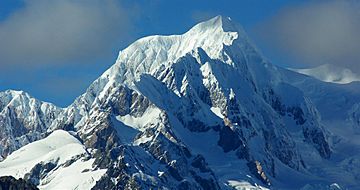Mount Tasman facts for kids
Quick facts for kids Mount Tasman |
|
|---|---|
 |
|
| Highest point | |
| Elevation | 3,497 m (11,473 ft) |
| Prominence | 519 m (1,703 ft) |
| Listing | New Zealand #2 |
| Naming | |
| Native name | Error {{native name}}: an IETF language tag as parameter {{{1}}} is required (help) |
| Geography | |
| Parent range | Southern Alps |
| Climbing | |
| First ascent | February 1895 by Edward Fitzgerald, Matthias Zurbriggen und Jack Clarke |
| Easiest route | glacier/snow/ice climb |
Mount Tasman (called Horokoau in Māori) is the second highest mountain in New Zealand. It stands tall at 3,497 meters (about 11,473 feet). You can find it in the Southern Alps, a big mountain range on New Zealand's South Island.
Mount Tasman is located just four kilometers north of Aoraki / Mount Cook, which is the tallest mountain in the country. Unlike Aoraki / Mount Cook, Mount Tasman sits right on the main ridge of the Southern Alps. This means it's on the border between two amazing places: Aoraki / Mount Cook National Park and Westland Tai Poutini National Park. It is also the highest point in the Westland District.
First Climbers
The very first time someone climbed to the top of Mount Tasman was in 1895. The climbers were Edward FitzGerald and his guide, Matthias Zurbriggen. They were the first people to successfully reach the summit of this challenging peak.
Its Special Name
The Māori name for Mount Tasman is Horokoau. This name has an interesting meaning! "Horo" means "to swallow," and "koau" means "shag." A shag is a type of bird that dives for fish. People believe the name refers to how a shag's neck swells up when it swallows a fish.
National Parks Around It
Mount Tasman is part of the Aoraki / Mount Cook National Park, located in the Canterbury area. This park was created in 1953. It's also part of a larger group of parks that are recognized as a World Heritage Site by UNESCO. These parks include Westland Tai Poutini National Park, Mount Aspiring National Park, and Fiordland National Park. Being a World Heritage Site means these areas are very important and special to the whole world.
Images for kids
See also
 In Spanish: Monte Tasman para niños
In Spanish: Monte Tasman para niños







